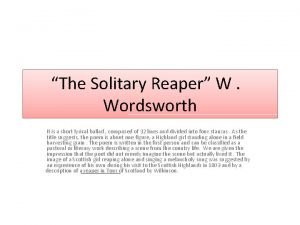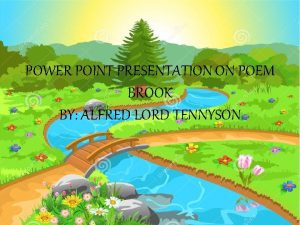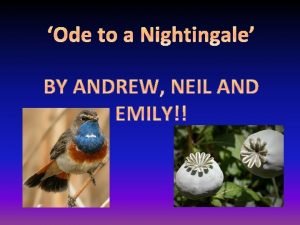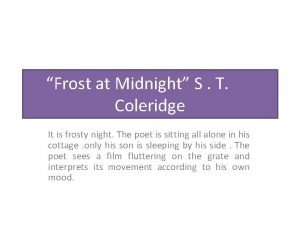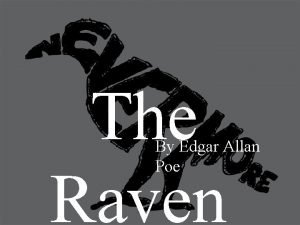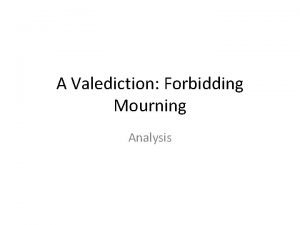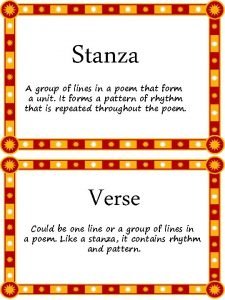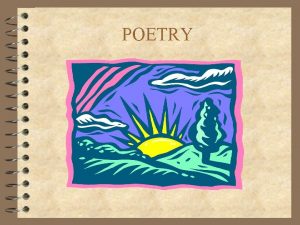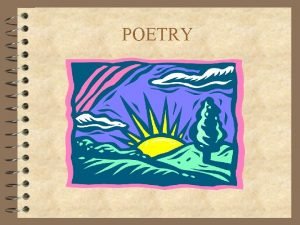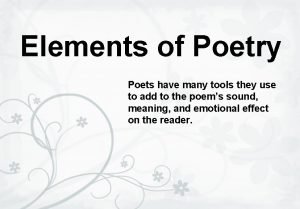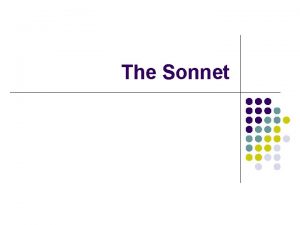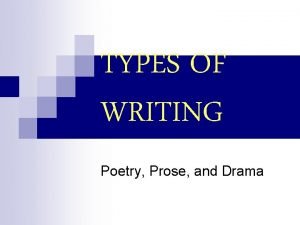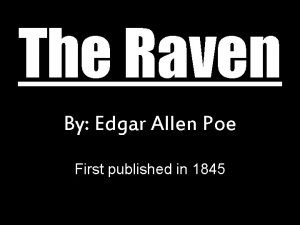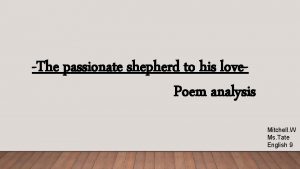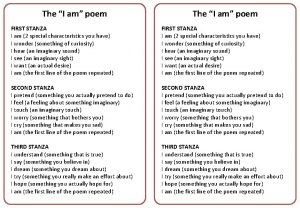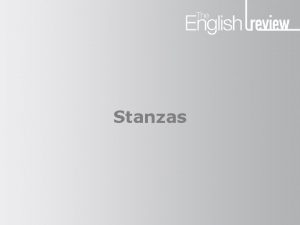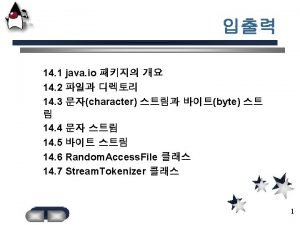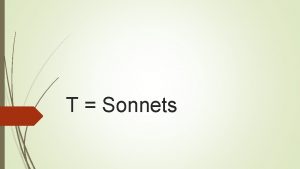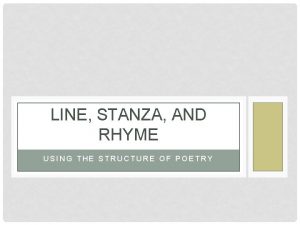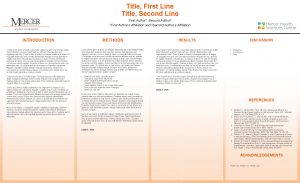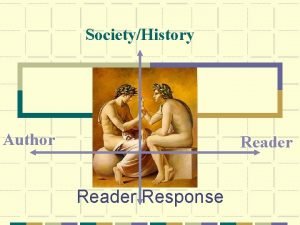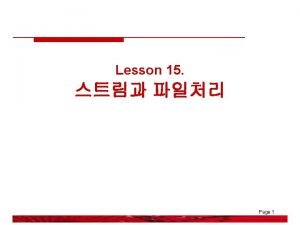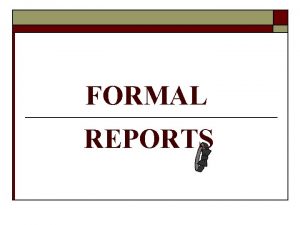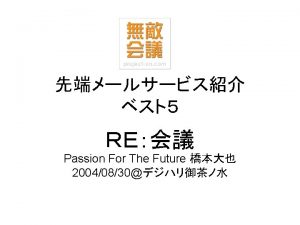First Stanza The first line takes the reader



















- Slides: 19

First Stanza The first line takes the reader straight into the ranks of the soldiers, an unusual opening, only we're told they resemble "old beggars" and "hags" (note the similes) by the speaker, who is actually in amongst this sick and motley crew. The initial rhythm is slightly broken iambic pentameter until line five when commas and semi-colons and other punctuation reflect the disjointed efforts of the men to keep pace. Also note the term "blood-shod" which suggests a parallel with horses, and the fact that many are lame, drunk, blind and deaf. The trauma of war has intoxicated the soldiers.

Second Stanza Suddenly the call goes up: "Gas!" We delve deeper into the scene as chemical warfare raises its ugly head and one man gets caught and left behind. He's too slow to don his gas mask and helmet, which would have saved his life by filtering out the toxins. "An ecstasy of fumbling, " the poet writes. The ecstasy is used here in the sense of a trance-like frenzy as the men hurriedly put on their helmets. It has nothing to do with happiness. Here the poem becomes personal and metaphorical. The speaker sees the man consumed by gas as a drowning man, as if he were underwater. Misty panes add an unreal element to this traumatic scene, as though the speaker is looking through a window.

Third Stanza Only two lines long, this stanza brings home the personal effect of the scene on the speaker. The image sears through and scars despite the dream-like atmosphere created by the green gas and the floundering soldier. Owen chose the word "guttering" to describe the tears streaming down the face of the unfortunate man, a symptom of inhaling toxic gas.

Fourth Stanza The speaker widens the issue by confronting the reader (and especially the people at home, far away from the war), suggesting that if they too could experience what he had witnessed, they would not be so quick to praise those who die in action. They would be lying to future generations if they thought that death on the battlefield was sweet. Owen does not hold back. His vivid imagery is quite shocking, his message direct and his conclusion sincere. The last four lines are thought to have been addressed to a Jessie Pope, a children's writer and journalist at the time, whose published book Jessie Pope's War Poems included a poem titled The Call, an encouragement for young men to enlist and fight in the war.

What Is the Main Theme of "Dulce et Decorum Est? " "Dulce et Decorum Est" does not have one theme, but many. Still, each of themes centre around war and the antiquated notions associated with it. The main themes of this poem are listed below: War One of the main themes of this poem is war. It deals with a soldier's experience in World War I, and contrasts the realities of war with the glorified notion of what serving in a war is like. Propaganda This poem takes aim at the idea of war presented by war-supporting propaganda. During World War I, propaganda came in the form of books, poems, posters, movies, radio and more, and presented an idea of war full of glory and pride rather than of death and destruction.

Politics are often the cause war, yet it is the men who have nothing to do with politics who are recruited to fight it. This poem underlines the wrongness of this dynamic. Hero Worship Everyone wants to be the hero. In reality, it is the man who keeps his head down is he who survives the longest. Patriotism "Dulce et decorum est pro patria mori, " means it is sweet and proper to die for one's country. This idea of patriotism fuelled the hopes and dreams of many young soldiers who entered World War I. Once they realised the horrors that awaited them, however, this ideal patriotism was rightly viewed as ridiculous.

Lessons Learned From the Past Owen highlights this Latin phrase to show antiquated and wrong it is when applied to the modern age. Through his work, which entirely destroys the idea that it is sweet and proper to die for one's country, he hopes to make readers realise that times have changed – that while war may have once been glorious, now, war is hell. What Is the Structure of "Dulce et Decorum Est? " "Dulce et Decorum Est" might have started out as a double sonnet (there are 28 lines in total) and many lines are in iambic pentameter, with end rhymes. Owen must have decided against it as he worked on the draft, ending up with four unequal stanzas.

How Is Language and Diction Used in "Dulce et Decorum Est? " "Dulce et Decorum Est" surprises the reader from the start. The opening lines contain words such as bent, beggars, sacks, hags, cursed, haunting, trudge. This is the language of poverty and deprivation, hardly suitable for the glory of the battlefield where heroes are said to be found. Yet this is precisely what the poet intended. Figurative language fights with literal language. This is no ordinary march. Most seem asleep, from exhaustion no doubt, suggesting that a dream world isn't too far distant–a dream world very unlike the resting place they're headed for. The second stanza's first line brings the reader directly in touch with the unfolding drama and, although these are soldiers, men (as well as old beggars and hags), the simple word "boys" seems to put everything into perspective.

Wilfred Owen makes use of numerous poetic devices in this poem. Aside from the structure, which is discussed above, Owen strategically uses assonance, alliteration, and iambic pentameter to transmit the dirty and dark feelings felt on the battlefield. Assonance It is important to note the poet's use of internal, line-by-line assonance. For example: double / under / cursed / sludge / haunting /turned / trudge. And again with: drunk / fumbling / clumsy / stumbling / under / plunges / guttering / flung / corrupted / lungs / cud / dulce Throughout the poem this is almost like the background rumbling of distant explosions.

Alliteration also occurs in lines five, eleven and nineteen: Line 5: Men marched asleep. Many had lost their boots Line 11: But someone still was yelling out and stumbling Line 19: And watch the white eyes writhing in his face

Iambic Pentameter The iambic pentameter is dominant, but occasional lines break with this rhythm, such as line sixteen in the third stanza. This inconsistency reflects the strangeness of the situation. Iambic pentameter is used in the following instances: outstripped Five-Nines This refers to the type of shell being used, a 5. 9 calibre, which were not up to the speed of other shells used. like a devil's sick of sin This is both a simile and a great use of iambic pentameter. Whatever you think a devil looks like, this is one that has gone beyond the pale.

bitter as the cud This is a term used in farming, where cud is the half digested food of ruminants which is chewed again to make it digestible. The suggestion is that the blood coming up from the lungs has to be chewed by the poor dying man. A sobering image. This line is very similar to the first line of Owen's poem "Anthem For Doomed Youth, " which reads, "What passing bells for these who die as cattle? " The Latin ending is perhaps a gentle reminder of many a slogan, many a motto and maxim held dear by clubs, military units, teams and families as an expression of belief and ideals. These are often displayed in Latin which was, of course, the language of the ancient Romans.

What Is the Tone and Mood of "Dulce et Decorum Est? " From the start of this poem you are immersed in the atmosphere of war. These are the trenches of WWI, full of mud and death. Once optimistic, healthy soldiers have now been reduced to a miserable, exhausted gang who have little left to give. It's a shocking environment into which the reader is taken–one that is oppressive, dangerous and without any real hope. The poet wants the reader to know that warfare is anything but glorious, so he paints a gloomy, realistic, human picture of life at the frontline. He leaves us no doubt about his feelings. The tone and mood is also set by language such as "misty panes and thick green light. " From the start we feel that the world has been turned upside down, and that all things having to do with happiness and vitality have been cast away. This is not a lively green, but a thick green. The window is not clear, but misty. This is the land of the walking dead, of the sickly–a world cold, muddy and metallic.

By the end of the poem, it appears the reader has been moved away from the "haunting" battlefield, and the setting becomes internal. Here, the mood is less gruesome, but no less pitiful. In one sense, to see the way these scenes of death and violence have affected the poet's mind is just as disturbing as the scenes themselves.

How Is Imagery Used in "Dulce et Decorum Est? " This poem is packed full of vivid images forged in the heat of battle, skillfully drawn by the young, keenly observant poet. The opening scene is one of a group of soldiers making their weary way from the frontline "towards our distant rest" as bombs drop and lethal gas is released. Details are intimate and immediate, taking the reader right into the thick of trench war. These men appear old, but that is only an illusion. War has twisted reality which gradually turns surreal as the poem progresses. The speaker evokes a dream-like scenario, the green of the enveloping gas turning his mind to another element, that of water, and the cruel sea in which a man is drowning. The descriptions become more intense as the drowning man is disposed of on a cart. All the speaker can do is compare the suffering to a disease with no known cure. The final image - sores on a tongue - hints at what the dying soldier himself might have said about the war and the idea of a glorious death.

What Are the Symbols Used in "Dulce et Decorum Est? " While Owen utilizes figurative language, similes, and assonance to combat the illusion that war is glorious, he also uses symbols to underline his message. There are three overarching symbols that strengthen the impact of "Dulce et Decorum Est. " Disfiguration Owen focuses on the way war disfigures and warps all things that come into contact with it. Primarily, he focuses on the human body and the way it is slowly damaged and changed before ultimately being destroyed. We see the symbol of disfiguration in the first stanza, when the poet reports on the state of his fellow men: Lines 1– 3 Bent double, like old beggars under sacks, Knock-kneed, coughing like hags, we cursed through sludge, Till on the haunting flares we turned our backs

Lines 5– 7 Men marched asleep. Many had lost their boots, But limped on, blood-shod. All went lame; all blind; Drunk with fatigue; deaf even to the hoots By looking closely at the language used in the above lines, the symbol of disfiguration becomes clear. The men are no longer the men the used to be. They are shadows of their former selves: dead men walking.

Allusion As we can see by the title and last line of this poem, one of the main symbols is allusion (in this instance, an allusion to Horace's Latin phrase). The allusion points to the idea that fighting and dying for your country is glorious. After making this allusion, the poet devotes all of his efforts to proving it wrong. The devil is also alluded to in line 20, indicating the badness of the battlefield. His hanging face, like a devil’s sick of sin;

Nightmares Another symbol that pervades this poem is the idea of the nightmare. Owen presents the scenes of war as a nightmare with their greenish color and mistiness. Also, the terrifying imagery adds to the feeling of a bad dream. This symbol indicates that the horrors of war are almost too hard to comprehend. This must be a nightmare, mustn't it? The reality is that it is not a nightmare: These are real atrocities that happened to real people. The fact that the poet presents the poem as a sort of nightmare makes it all the more terrible. Sources Norton Anthology of Poetry, 2005, Norton
 Solitary reaper paraphrase stanza by stanza
Solitary reaper paraphrase stanza by stanza By thirty hills i hurry down
By thirty hills i hurry down Ode to a nightingale stanza 1
Ode to a nightingale stanza 1 Frost at midnight line by line explanation
Frost at midnight line by line explanation What is the main message of the raven
What is the main message of the raven All in a hot and copper sky the bloody sun at noon
All in a hot and copper sky the bloody sun at noon A valediction: forbidding mourning analysis
A valediction: forbidding mourning analysis This is a group of lines in a poem
This is a group of lines in a poem See it through poem
See it through poem Four-line stanza
Four-line stanza Sonnet examples
Sonnet examples Sonnet examples
Sonnet examples Pantoum examples
Pantoum examples Eg subject code
Eg subject code Forms poetry
Forms poetry The road not taken theme
The road not taken theme The raven stanza 17
The raven stanza 17 Shepherd poem
Shepherd poem What is a stanza in a poem
What is a stanza in a poem What is a stanza in a poem
What is a stanza in a poem
